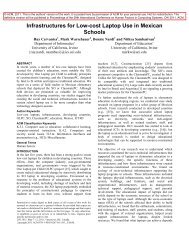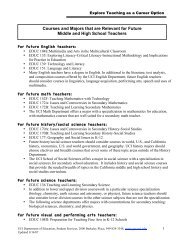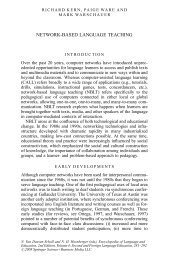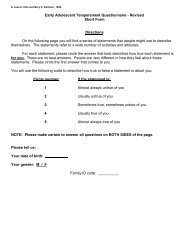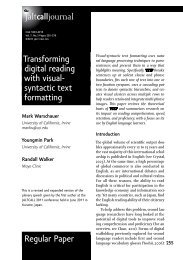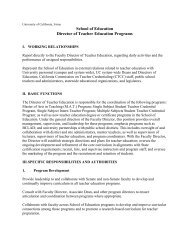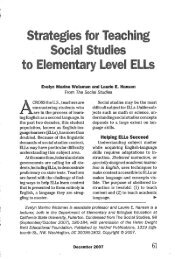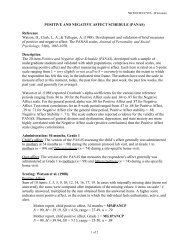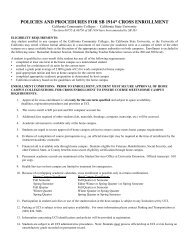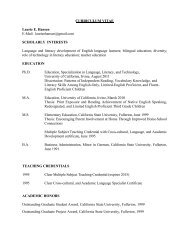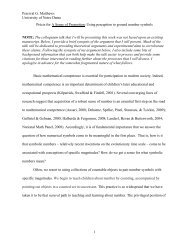Parental Modernity Scale ID.pdf
Parental Modernity Scale ID.pdf
Parental Modernity Scale ID.pdf
Create successful ePaper yourself
Turn your PDF publications into a flip-book with our unique Google optimized e-Paper software.
NICHD SECCYD—Wisconsin<br />
PARENTAL MODERNITY SCALE<br />
Reference<br />
Schaefer, E. S., & Edgerton, M. (1985). Parent and child correlates of parental modernity. In I. E.<br />
Sigel (Ed.), <strong>Parental</strong> belief systems: The psychological consequences for children (pp. 287-318).<br />
Hillsdale, NJ: Erlbaum.<br />
Description<br />
The <strong>Parental</strong> <strong>Modernity</strong> <strong>Scale</strong>, identified as Ideas about Raising Children in the site-specific<br />
questionnaire battery, is a 30-item measure of traditional, authoritarian parental beliefs and<br />
progressive, democratic beliefs. Each item is rated on a 5-point scale ranging from 1 = strongly<br />
disagree to 5 = strongly agree. Two scores are computed, Progressive Beliefs and Traditional<br />
Beliefs.<br />
Administration: 54 months<br />
This measure was administered to mothers at 54 months (n = 90) during the common protocol<br />
lab visit. It also was administered as part of the common protocol (identified as Ideas about<br />
Raising Children) to mothers at 1 month and Grades 1 & 4; to fathers/partners at Grades 1 & 4;<br />
to child care providers at 6, 15, 24, 36, & 54 months; to after-school care providers at Grades 1,<br />
3, 4, & 5; and to lab friend mothers at Grades 4 & 6.<br />
Scoring: Schaefer & Edgerton (1985)<br />
Progressive Beliefs<br />
Sum of 8 items: 6, 11, 13, 15, 20, 23, 27, 29. In cases with internally missing data (items not<br />
answered), the sums were computed after imputation of the missing values: # items on scale / #<br />
actually answered, multiplied by the sum obtained from the answered items. A higher score<br />
reflects progressive (modern) beliefs about childrearing and education.<br />
M54PMPRO<br />
N = 89, M = 33.71, SD = 3.62, range = 22-40, α = .69<br />
Traditional Beliefs<br />
Sum of 22 items: 1-5, 7-10, 12, 14, 16-19, 21, 22, 24-26, 28, 30. In cases with internally missing<br />
data (items not answered), the sums were computed after imputation of the missing values: #<br />
items on scale / # actually answered, multiplied by the sum obtained from the answered items. A<br />
higher score reflects traditional (strict, conservative) beliefs about childrearing and education.<br />
M54PMTRA<br />
N = 89, M = 56.12, SD = 13.12, range = 26-89.05, α = .85<br />
Total Traditional Beliefs<br />
To be consistent with the scoring for this measure in the NICHD study’s common data set, we<br />
also computed a Total Traditional Beliefs score as the sum of the Traditional items and the<br />
Progressive items, with the Progressive items reversed. In cases with internally missing data<br />
(items not answered), the sums were computed after imputation of the missing values: # items on<br />
scale / # actually answered, multiplied by the sum obtained from the answered items. A higher<br />
score reflects more traditional beliefs about raising children.<br />
M54PMTOT<br />
N = 89, M = 70.40, SD = 15.16, range = 38-107, α = .87<br />
1 of 2
NICHD SECCYD—Wisconsin<br />
Analysis Data Set<br />
SS54MO<br />
Raw Data Set<br />
M54IRC<br />
2 of 2



